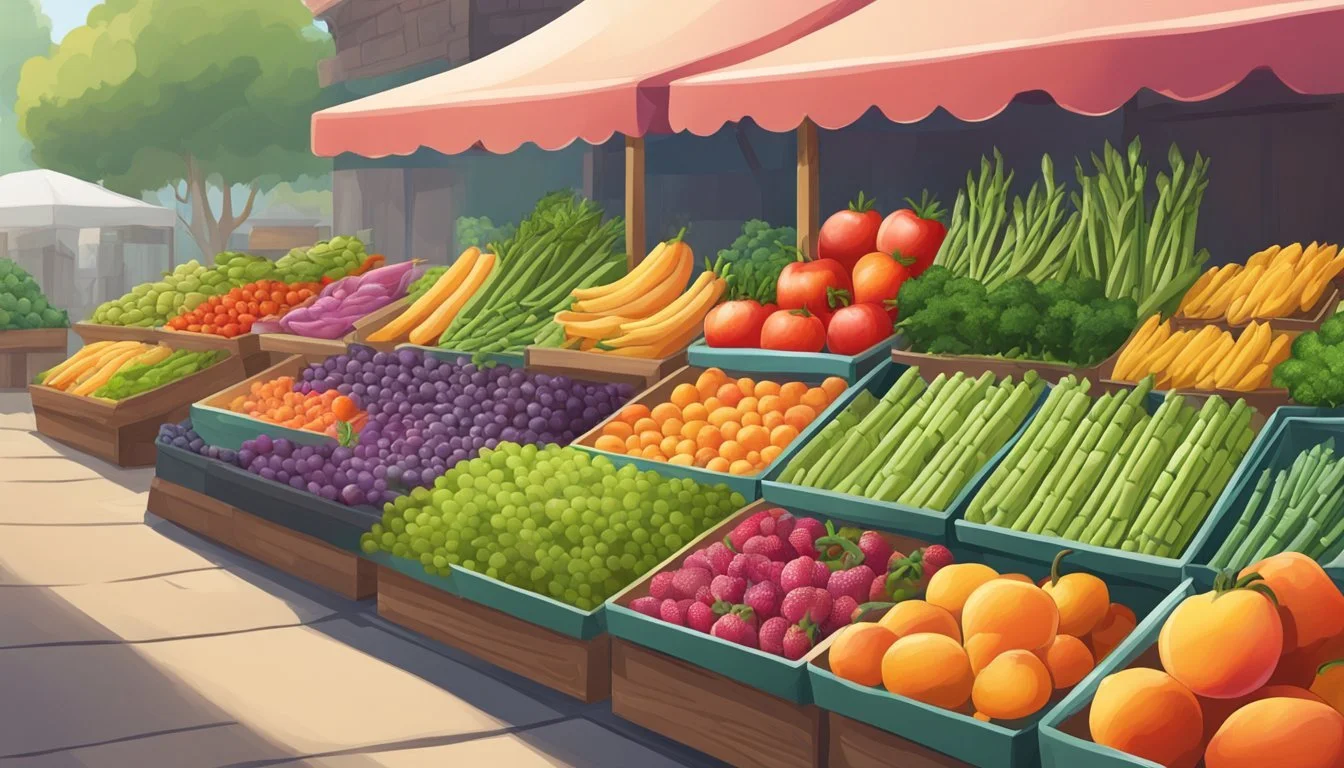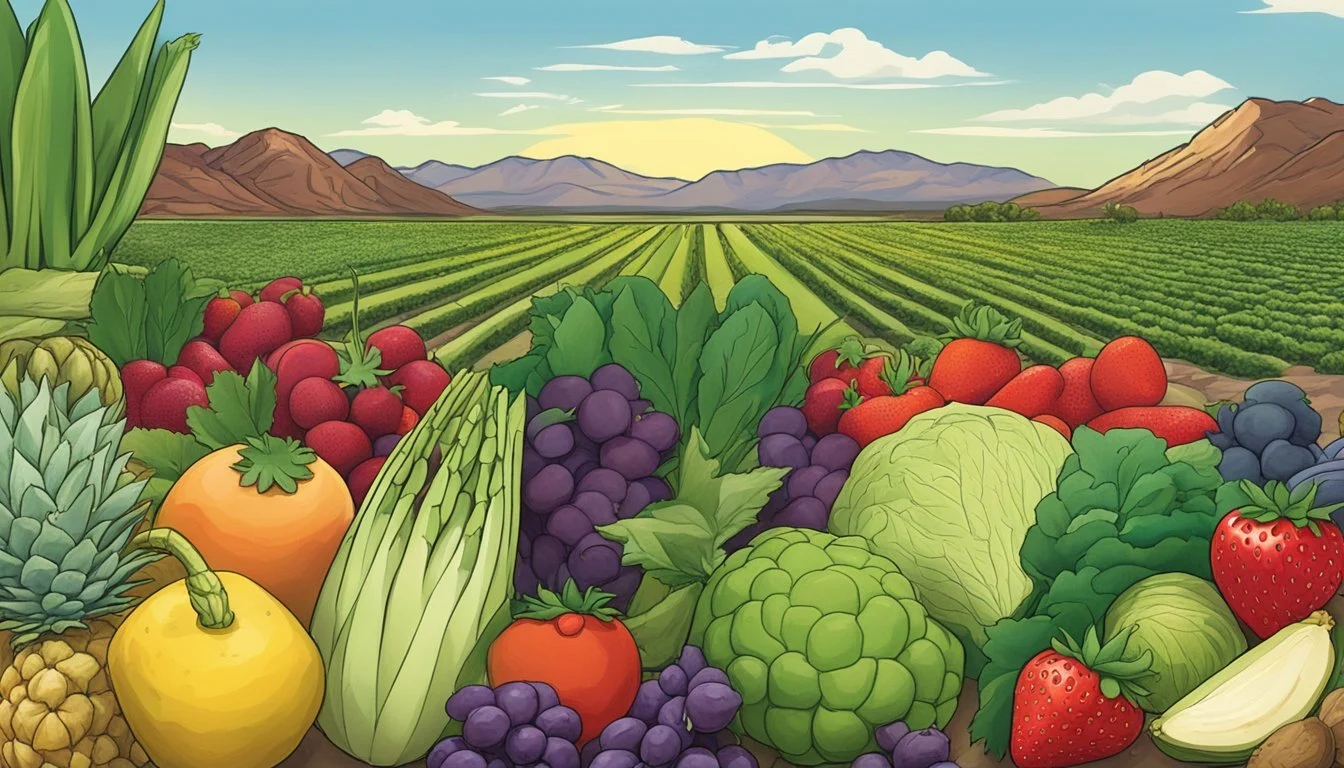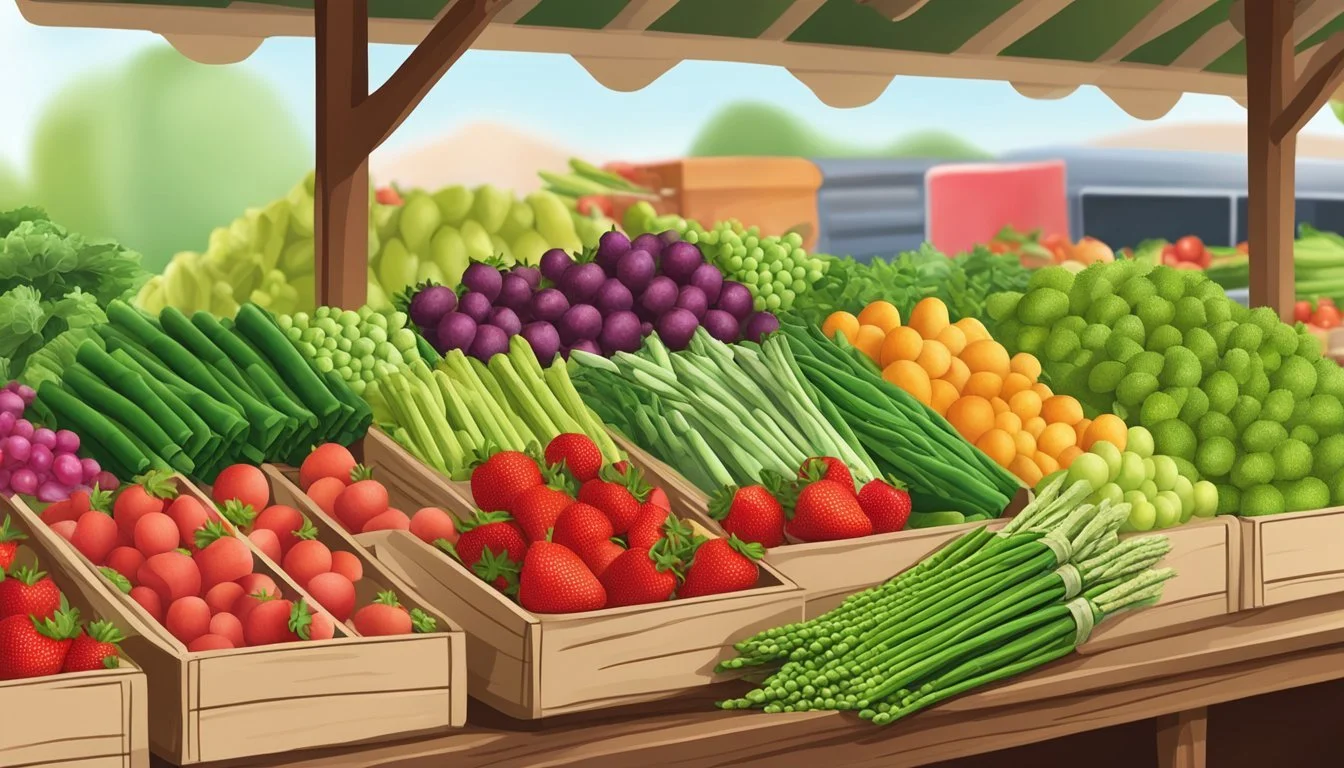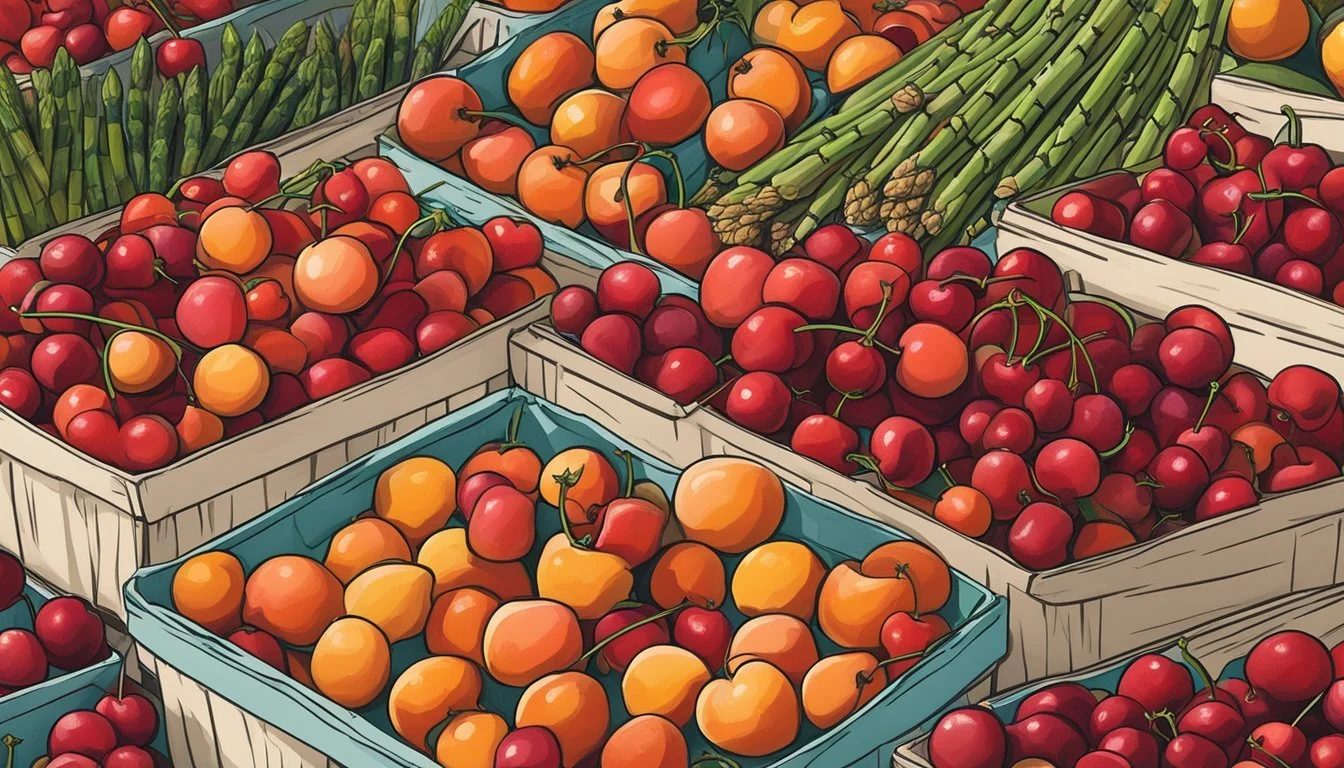Nevada Seasonal Fruit & Vegetables in April
Your Fresh Guide
This Article is Part of our Nevada Seasonal Fruit & Veg Calendar
Seasonal produce offers a variety of benefits, from enhanced flavor to environmental sustainability. In Nevada, the month of April sees a shift in the agricultural calendar, bringing forth a fresh assortment of fruits and vegetables that thrive in the state's unique climate. Amidst the extremes of temperature and aridity characteristic of this region, farmers adapt by selecting crops that are ideally suited to the local growing conditions.
As winter recedes, April heralds the arrival of spring's tender crops. Leafy greens such as lettuce and spinach are in their prime, packed with nutrients and flavor. These versatile vegetables serve as a foundation for salads and can also be cooked in a variety of ways. Due to Nevada’s dry climate and temperature ranges, the growth window for such greens is well-timed for April harvests.
Cruciferous vegetables like broccoli (how long does broccoli last?)and cauliflower (how long does cauliflower last?) also make their appearance in Nevada's April markets. Their adaptability to the colder nights and warmer days of the season allows them to mature into crisp, flavorful produce. These vegetables are not only favorites for their taste but also for their health benefits, as they are rich in vitamins and fibers. As the season progresses, they will continue to be available, providing Nevadans with fresh options for healthy eating.
Overview of Nevada's Seasonal Cycles
In Nevada, the shifts between winter, spring, summer, and fall bring changes to the availability of local produce. Nevada's diverse climate zones range from the cooler, higher elevations to the warmer, lower valleys, impacting the seasonal cycles of fruits and vegetables.
Spring ushers in a rejuvenation of plant life as temperatures rise. April in Nevada is particularly vibrant with the emergence of tender greens and the continuation of cool-season crops that began in late winter. Gardens and farms across the state start to yield:
Asparagus (What wine goes well with asparagus?)
Broccoli
Cauliflower
Lettuce
Radishes
As the summer heat intensifies, the produce selection expands significantly. Starting in June, fruits and vegetables that thrive in warmer temperatures become abundant. This season hails the arrival of:
Cherries (how long do cherries last?)
Corn
Cucumbers
Tomatoes
Zucchini
Fall offers a bountiful harvest before the first frosts. Produce like squashes and root vegetables come into their prime, peaking during this time. Examples of fall produce are:
Apples
Pumpkins
Squashes
Pears
When winter descends, Nevada experiences a cool down, yet some resilient crops remain in season. Hardy greens and some root vegetables can withstand the colder temperatures:
Collard Greens (how long do collard greens last?)
Leeks
Spinach
Throughout these seasonal cycles, Nevada provides a range of in-season fruits and vegetables that reflect the state's adaptability and agricultural resourcefulness. Consumers can enjoy fresh, local produce by following these natural cycles and supporting Nevada's farmers.
Fruits and Vegetables to Expect in April
In April, Nevada's produce selection begins to diversify, offering a variety of fruits and vegetables that are both flavorful and nutritious.
Vegetables:
Asparagus: This versatile vegetable is in its prime, known for its tender spears that are perfect for a range of culinary uses.
Beets: Rich in color and nutrients, beets are ideal for both sweet and savory dishes.
Carrots: They remain a staple, sporting their sweetness that intensifies when roasted.
Leeks: With their mild onion-like taste, leeks enhance the flavor profile of soups and stews.
Greens: April marks the season for a variety of greens, such as:
Spinach
Arugula
Lettuces These leafy vegetables are perfect for refreshing salads and smoothies.
Beans and Peas: Both legumes start becoming available, featuring prominently in soups, salads, and sides.
Fruit:
Strawberries: One of the first fruits to make an appearance, strawberries offer a sweet and tangy flavor, ideal for desserts or as a fresh snack.
While April in Nevada does not yield an extensive variety of fruits, the state's focus remains on vegetables, particularly root vegetables and hardy greens that thrive in the cool spring climate. Consumers can enjoy these seasonal offerings with the assurance that they are experiencing produce at its peak freshness and nutritional value.
Preparing for Late Spring Harvest
As temperatures in Nevada warm up in late spring, gardeners and farmers start to ramp up activities for both vegetable planting and fruit cultivation. This period is critical for establishing plants that will yield produce throughout the summer.
Vegetable Planting and Growth
In Nevada, late spring presents a window for planting a variety of vegetables that thrive in the coming warm weather. Gardeners should focus on planting heat-tolerant varieties that can withstand the state's dry conditions.
Key Vegetables for Late Spring Planting:
Herbs: These can be planted now to ensure a continuous supply throughout the summer. Consider basil, parsley, and cilantro.
Kale: Tough and hearty, kale can be planted now for an early summer harvest.
Lettuce: Opt for heat-resistant varieties to avoid bolting as temperatures climb.
Onions: Plant seedlings or sets now for a late summer harvest.
Radishes: A fast-growing crop, radishes can be sown now for a quick harvest.
Turnips: Plant turnips now for both their roots and greens.
When planting, ensure soil is well-draining and enriched with compost for optimal plant growth and health.
Fruit Cultivation Techniques
Fruit cultivation in April requires attention to both existing fruit plants and preparing for new ones.
Fruit-Related Activities Include:
Tomatoes: They should be started in greenhouses or indoors to be transplanted after the last frost. Use stakes or cages for support as they grow.
Cucumber: Ideal for trellising to maximize space and sun exposure, plant cucumber seeds after the danger of frost has passed.
For fruit trees and shrubs already in the ground, April is the time for:
Pruning to ensure healthy growth and air circulation.
Fertilizing to provide essential nutrients for fruit development.
Each action taken in late spring can significantly impact the quality and quantity of the harvest. Gardeners should monitor water levels closely, as Nevada's arid climate can quickly deplete soil moisture, even during cooler spring days.
Farmers Market Guide for April in Nevada
In Nevada, April ushers in a modest variety of seasonal produce at local farmers' markets. Patrons can expect the first waves of spring vegetables, though the fruit selection remains limited during this period.
Vegetables:
Fresh cabbage and cauliflower are among the highlights, as these hardy vegetables come to harvest. They can be found fresh and crisp, perfect for spring salads and roasts.
Cabbage: Smooth leafy heads ideal for slaws and fermentation.
Cauliflower: Versatile for both raw and cooked applications.
Fruits:
While stone fruits like apricots and cherries are associated with spring, their presence in April's farmers' markets in Nevada might be scarce, as they typically ripen later in the season. However, visitors might still encounter storage varieties of apples, which maintain their quality for several months post-harvest.
Apples: Late-season varieties available from cold storage.
Unavailable Produce: Certain produce like cherries, apricots, and pumpkins are not typically found in April. Cherries and apricots have yet to ripen during this month, and pumpkins are a staple of autumn, far removed from April's offerings.
Despite the leaner selection, the farmers' markets in Nevada still provide a good opportunity to enjoy local, seasonal produce. Shoppers can take confidence in purchasing fresh, quality vegetables while anticipating the arrival of a broader spectrum of fruits and vegetables in the coming months.
Gardening Tips for Nevada's April Produce
April in Nevada offers a prime window for planting a variety of fruits and vegetables. Gardeners should prioritize soil maintenance, water management, and pest control to ensure a healthy harvest.
Soil Maintenance
For optimal growth, artichokes (What wine goes well with artichokes?)require nutrient-rich, well-draining soil. One should incorporate organic compost into the planting beds to enhance soil fertility. When planting mushrooms, wood chips or straw can be mixed into the soil as they thrive in rich, damp, and shaded environments.
Scallions and snap peas benefit from loamy soil with good drainage.
pH Levels: Aim for a soil pH between 6.0-7.0 for most vegetables.
Water Management
Proper irrigation is vital in Nevada's arid climate. Drip irrigation systems can provide consistent moisture to the roots while conserving water.
Artichokes: Require deep, infrequent watering to encourage root development.
Snap peas: Need regular watering to maintain moist soil.
Pest Control
A proactive approach to pest control can protect the April crops from common pests.
Artichokes: Protect from aphids with insecticidal soap or neem oil treatments.
Mushrooms: Keep plots clear of debris to discourage pest infestation.
Scallions: Use floating row covers to protect young plants from thrips.
Snap peas: Introduce beneficial insects like ladybugs to manage aphid populations.
Health Benefits of Eating Seasonal
Eating seasonal produce, such as the variety available in Nevada during April, offers numerous health benefits. Flavor is enhanced when fruits and vegetables are picked at their peak; they taste fresher and are typically juicier. Nutrition is also at its highest when produce is in season. These foods have had the proper time to grow and mature, resulting in higher levels of vitamins and minerals.
For example, greens harvested in the spring, like spinach and arugula, are not only vibrant and flavorful, but they are also packed with vital nutrients such as vitamin C, iron, and fiber. These leafy greens can support a healthier immune system and promote digestive health.
Strawberries, another seasonal produce in April, offer an exceptional taste that is much richer than their off-season counterparts. They provide a high dose of vitamin C, antioxidants, and phytochemicals that can help combat inflammation and support heart health.
Seasonal Produce Health Benefits Greens High in iron, vitamin C, fiber Strawberries Rich in vitamin C, antioxidants
Consumers who choose seasonal produce are not only enjoying food that tastes better and is nutritionally superior. They also often consume a wider variety of foods throughout the year, leading to a more diverse and balanced diet. This diversity ensures a range of nutrients that are essential for the body's various functions.
Opting for seasonal eating is a confident step towards a sustainable lifestyle that has clear health advantages. When individuals select local, seasonal food, they benefit not only their health but also the environment, as there is often less transportation and storage involved.
Environmental Impacts and Sustainability
Consuming seasonal fruits and vegetables in Nevada can lead to more sustainable dietary patterns. Seasonal produce often requires less auxiliary energy for growth and storage than out-of-season counterparts that need controlled environments. By preferring produce that naturally thrives in April, such as asparagus and spring greens, consumers can lower the food's lifecycle environmental footprint that includes factors like transport, storage, and energy consumption.
Nevada's climate lends itself to certain crops more efficiently during specific times of year, making these crops more sustainable choices when they are in season. For example, April might see an increase in the availability of tender greens, which can be grown with minimal additional water or energy input — a crucial aspect, given the state's arid climate and water use concerns.
Local seasonal produce typically travels shorter distances to market, which reduces greenhouse gas emissions from transportation.
Sustainable agricultural practices in Nevada can include rotation of crops and reduced use of chemicals, which helps maintain soil health.
Moreover, supporting local agriculture by consuming Nevada's seasonal output boosts the local economy and promotes agricultural practices that are more likely to be tailored to the specific regional environment, thus promoting sustainability on multiple levels.
Finally, it should be noted that while choosing seasonal and local produce can have a positive impact, consumers should also be aware of the agricultural practices behind their food to make the most sustainable choices.
Recipes and Cooking Ideas for April Produce
In Nevada, April's bounty brings a collection of delights that offer a refreshing variety to any meal. Asparagus, a springtime favorite, is tender and bursting with flavor. One can oven-roast it with a drizzle of olive oil and a sprinkle of sea salt (how long does sea salt last?), or incorporate it into a frittata with green onions for a savory breakfast option.
Peas are another versatile April gem. They add a sweet pop of green to pasta (how long does pasta last?) dishes and risottos. Try them in a creamy pasta primavera (What wine goes well with pasta primavera?) or simply sauté with mint for a refreshing side dish.
Speaking of mint, it’s a great time to let this aromatic herb shine. It's perfect for infusing freshness into a variety of recipes. For a quick and easy use, blend it into a pea and mint soup that embodies the essence of spring.
Ingredient Suggested Dish Asparagus Grilled Asparagus with Lemon Butter Peas Pea and Mint Salad Green Onions Green Onion and Cheddar Scones Mint Mint Chocolate Chip Ice Cream New Potatoes Herb-Roasted New Potatoes Watermelons Watermelon, Feta, and Mint Salad
The often-overlooked new potatoes have a distinct, earthy flavor that makes them perfect for roasting. Toss them with olive oil, rosemary, and garlic for a comforting dinner accompaniment.
For a sweet finish or a fresh start, watermelons enter the scene. Although not at the peak of their season, early watermelons can still be found. A salad of watermelon cubes, feta cheese, black olives, and fresh mint can serve as a refreshing starter, or as a dessert, watermelon slices with a hint of lime zest offer a simple and hydrating treat.
These are just a few ways to celebrate Nevada's April produce through vibrant and flavorful dishes.
Storing and Preserving Tips
When it comes to preserving the fresh flavors of Nevada's seasonal produce, such as herbs, greens, strawberries, and rhubarb, proper storage methods are paramount. Each category of produce has specific needs to maintain freshness and extend shelf-life.
Herbs like basil and mint benefit from being stored in an upright position in water, akin to fresh-cut flowers. To retain their vibrant flavors, one can also chop the herbs and freeze them in an ice cube tray with water or olive oil.
Greens, including spinach and lettuce, require gentle handling. These leafy vegetables should be wrapped in a paper towel to absorb excess moisture and refrigerated in airtight containers or bags. This method helps in keeping them crisp and prevents wilting.
When it comes to strawberries, maintaining their just-picked taste involves hulling and arranging them in a single layer on a baking sheet to freeze. Once frozen solid, they can be transferred to airtight containers or bags. This prevents the strawberries from becoming mushy and clumping together.
Rhubarb has a high water content, making it prone to ice crystal formation which can lead to sogginess. To preserve rhubarb, one should chop it and blanch it briefly before freezing, which helps keep its texture intact.
Produce Preparation Storing Method Herbs Chop, place in water/olive oil Freeze in ice cube trays Greens Wrap in paper towel Refrigerate in airtight containers/bags Strawberries Hull, freeze on baking sheet Transfer to airtight containers/bags Rhubarb Chop, blanch Freeze
By adhering to these tailored tactics, the bounties of Nevada's April harvest can be savored well beyond their picking season.
Month-by-Month Guide to Nevada's Produce
In the shifting climates of Nevada, each month showcases a variety of fresh produce, offering a delightful selection for locavores and seasonal eaters.
January sets the year with cool weather crops such as leeks, lettuce, radishes, and spinach. Visitors and residents alike can look out for winter squashes and root vegetables that often carry through from the fall.
With February, the state persists with a similar assortment, where options like green garlic, onions, shallots, and turnips line the markets, continuing the span of cool hearty vegetables.
As March arrives, there's a slight shift towards spring with the presence of asparagus, broccoli, Brussels sprouts, and cauliflower. Green herbs like dill begin to make an appearance, and the touch of green garlic remains.
While April details are not specifically listed, one could anticipate the vegetal trend of March extending into April with possibly increased availability and the introduction of some new spring items.
May introduces warmer days and brings basil into full swing. Produce begins to brighten with a wider range of items like beets becoming ready for harvest.
The arrival of June signals the start of summer fare with blackberries and blueberries. It's a period when one can expect the onset of more fruit varieties, complementing the array of available vegetables.
As the heat intensifies in July, the selection broadens with the addition of broccoli, which continues to be a staple through to October, while cabbage and carrots become abundant.
August not only maintains the summer's plentiful produce but introduces cantaloupes, making a sweet entrance mid-month through mid-October.
When September calls, it's time for broccoli raab to join the ranks, while cabbage thrives into November.
October and November nurture the final waves of carrots, cauliflower, and cantaloupes, while preparing for the colder months ahead.
December, although not covered in the search results, typically features similar produce as January, given the seasonal cycle and cold weather patterns.
Supporting Local Agriculture
Nevada's local agriculture is a vital part of the state's economy and community life. By opting for produce from farmers' markets, residents actively contribute to the sustainability and growth of the community's agricultural base. April marks a time when local produce slowly starts to become more abundant, following the sparse winter months.
Farmers Markets: They are the epicenters of local produce and serve as a direct link between consumers and growers. They not only provide a platform for Nevada-grown fruits and vegetables but also foster relationships within the community by offering fresh, seasonal produce.
Accessibility: Easy access to locally grown products.
Freshness: Offering seasonal produce at its peak.
Local agriculture thrives when consumers make conscious choices. Here’s how:
Economic Stability: Money spent on local produce stays in the community, bolstering the local economy.
Community Health: Fresh, nutrient-rich produce is more accessible, promoting better health.
Environmental Impact: Reduced transport distances mean a smaller carbon footprint.
Table of Seasonal Produce Available in Nevada Farmers Markets in April:
Fruits Vegetables (Not in season) Asparagus Mixed greens Spring onions
Local agriculture is intrinsically linked to Nevada's identity, with seasonal cycles dictating the ebb and flow of available produce. By supporting local farmers and producers, Nevadans ensure a robust agricultural sector for future generations.












